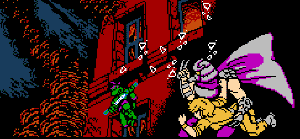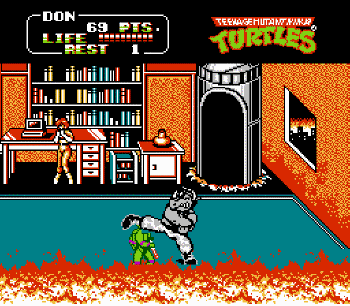 One
of those games every kid in America had to have, the non-sequel sequel to the original Teenage Mutant Ninja Turtles
is a translation of a superbly done arcade beat-em-up. It has
almost nothing to do with the first NES Turtles title (though the roman numeral indicates
otherwise), and the beat-em-up style the series would be known for is in its infancy here.
The Arcade Game suffers from technical problems, including the hit detection that
slaughters this game before it even has a chance.
One
of those games every kid in America had to have, the non-sequel sequel to the original Teenage Mutant Ninja Turtles
is a translation of a superbly done arcade beat-em-up. It has
almost nothing to do with the first NES Turtles title (though the roman numeral indicates
otherwise), and the beat-em-up style the series would be known for is in its infancy here.
The Arcade Game suffers from technical problems, including the hit detection that
slaughters this game before it even has a chance.Two-player co-op is the best reason to play this one, as it is for any beat-em-up. All four of the Turtles are selectable, though there is nothing to vary them. Slight changes to the sprites and their weapons are the only changes. Exclusive to the NES version are two levels not found in the arcade game, including an enjoyable one in a snow covered Central Park.
Getting there isn't much a problem if you can hit two buttons at once. That will perform a jumping attack that can knock out most basic enemies with a single swipe. This is how you'll need to take down most enemies. Jump kicks are also effective, though it will take more hits to do the job.
 Standard attacks on the other hand are
useless. There's a delay between the time a hit connects and when the second attack is
allowed to follow up. Even though the collision is obviously made, the game refuses to
register it unless it's past that timing mark. It's not particularly fair or fun and it's
the only reason you'll die in this game aside from the boss fights. Combos then, which are
crucial to the genre, are non-existent.
Standard attacks on the other hand are
useless. There's a delay between the time a hit connects and when the second attack is
allowed to follow up. Even though the collision is obviously made, the game refuses to
register it unless it's past that timing mark. It's not particularly fair or fun and it's
the only reason you'll die in this game aside from the boss fights. Combos then, which are
crucial to the genre, are non-existent.There's nothing to alleviate this. It's the way this one was coded. When you were 10, you didn't notice it, but time has not been kind. This is a critical, ridiculous, and inexcusable flaw. It doesn't feel anything like the arcade game, and calling it such is seemingly a way to disappoint gamers even more.
There was obviously more attention paid to the aesthetic look. Aside from the blatant Pizza Hut ads everywhere, this is a fair representation of the full sized cabinet on 8-bit hardware. The usual flicker doesn't cause much trouble, and the pleasant music creates varied moods depending on the stage.
While the developers managed to get the difficulty down to a reasonable level this time, they also failed to see why this version of the game didn't work. If it weren't for the license, no one would have found this entertaining. It's sloppy, and the only logical reason was a rushed development time. Take your need for beat-em-ups elsewhere.